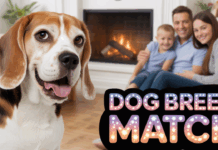Last Updated on January 15, 2022 by Dogs Vets
Top 21 of the laziest dog breeds, perfect for the owner who likes to stay in bed all day.
There is no “lazy“ dog breed in particular. All breeds of dogs can be lazy and this article will explore the top 21 laziest dog breeds.
The fact that you prefer to spend less time outside and more time lounging on the couch with your best friend does not make you a bad owner of a lazy dog breed.
Why Do We Want Dogs to Be Lazy?
Dogs are the best pets that we can ever have. They are loyal, energetic, and playful. However, there is one thing that they lack – laziness.
We want to make sure that our dogs are not too active because it will be hard for us to handle them (especially if they are hyperactive). We also want them to be lazy because it will make them feel more comfortable and relaxed.
There are many benefits of having a lazy dog in your house. For example, if you have a lazy dog then you will not have to worry about your pet running away from home or getting lost on the streets.
You won’t need to worry about your dog bothering people in public places or being too active during night-time when you’re trying to. A new study has shown that dogs are calmer and less active when they are on the Pill.
What Makes Some Dogs Lazy?
There are many reasons why some dogs are lazy. Some breeds of dogs are naturally lazy, they have a low energy level. Other breeds have an underdeveloped nervous system that makes them less active.
Some dog owners believe that their dog is lazy because they don’t get enough exercise. This is not the case for all breeds of dogs, but it can be a contributing factor to a dog being less active than it should be.
The 3 Most Common Reasons Why A Dog Would Be Lazy
Some dogs are just naturally lazy, while others are lazy because of their environment. Some dogs are also lazy because of their owners.
1) A dog can be naturally lazy if they have a breed that is prone to being more relaxed or laid back. These breeds include the Bulldog, Basset Hound, and Bull Terrier.
2) A dog can be lazy if they live in an environment where there is not much for them to do. They may also not get enough exercise in this environment. This is especially true if the owner does not take the dog on walks or play with them regularly.
3) A dog may be left alone too often by their owner which can lead to them being bored and becoming more lethargic over time.
If you’re seeking a couch potato friend, one of these Top 21 lazy dog breeds might be just what you’re looking for.
Please do not misunderstand me. You’ll need to make sure your dog receives plenty of exercises — no matter what breed you choose, every canine requires at least the bare minimum in terms of physical and mental stimulation in order to live a long and healthy life.
In the unfortunate event that you believe that lazy dog breeds are always lounging around, you will be proven incorrect.
Even the most sluggish and laziest dog will require daily walks and playtime to maintain their health.
The main distinction between lazy dog breeds and more active dog breeds is that lazy dog breeds lead a far more sedentary lifestyle than more active dog breeds.
While Labradors will spend the majority of their day playing, several of the breeds on this list will only be up for a few short walks each day and will prefer to spend the remainder of their time relaxing on their bed or your sofa.
That being said, if that is what you are searching for, then adopting one of these sluggish dogs will provide you with the perfect companion.
Top 21 Most Lazy Dog Breeds
Perfect for dog owners who like to stay in bed all day.
#1. The English Bulldog
Despite their size, English Bulldogs are gentle and patient dogs who enjoy spending time with their owners. They are unable to engage in rigorous exercise because they are brachycephalic (have a short, pushed-in nose).
For this sedentary species, a quick stroll around the park is sufficient exercise.
This calm and fearless breed will keep you laughing with their goofy nature, but they’re more interested in eating their favourite dog foods and napping as much as they possibly can.
The fact that they are little in stature yet extremely tough makes them a fantastic choice for households with boisterous children.
#2. The Bullmastiff
Bullmastiffs are the ultimate “gentle giants,” as the saying goes. The fact that these canines are a little on the sluggish side does not diminish their bravery or loyalty to their master.
Bullmastiffs, despite the fact that they are enormous dogs, are not hyperactive and adapt well to living in apartments.
These dogs are also affectionate, and if you allow them, they will attempt to climb into your lap.
#3. The Cavalier King Charles Spaniel is yet another breed of lazy dog.
The Cavalier King Charles Spaniel is a devoted and affectionate companion. There is nothing this breed enjoys more than spending quality time with its owners and showering them with kisses.
They enjoy taking short walks, but they are most at ease curled up on the couch with their buddies after a satisfying Cavalier dinner.
The Cavalier King Charles Spaniel is an affectionate and gentle dog breed that is an excellent choice for a household interested in lazy dog breeds.
#4. Bichon Frise (also known as a Bichon Frise)
Bichon Frises have a strong desire to please their owners. They are exceptionally bright and enjoy demonstrating their abilities.
These pups are easy to teach in terms of obedience, although some of them struggle with housebreaking at the beginning.
Bichons will have small bursts of activity followed by a very extended snooze if they are not exercised. This is one of the more sedentary dog breeds, and only a few brief walks throughout the day will be required.
They’ll go outdoors and burn off some of their excess energy before coming inside and curling up on the couch with you.
#5. The Japanese Chins
Japanese Chins were originally meant to be lap dogs, and they are always eager for a snuggle. They are extremely friendly, however, they should be closely monitored when around young children.
The Japanese Chins’ notion of exercise is to jump up into people’s laps as a form of exercise.
The breed is actually from China, and it is a popular choice among owners who are looking for a smart canine companion.
The Japanese Chin is one of the most intelligent and endearing canine breeds, and it is also one of the most lethargic.
#6. Pekingese (also known as the Pekingese dog)
The Pekingese is not a fan of exercise in any way, and it is for this reason that they are famous.
Their short bowlegs make it difficult for them to run around excessively, so they prefer to spend their time lying on the laps of their devoted pet owners, who will care for and feed the sluggish canine companion.
Pekingese are excellent lap dogs and are popular among pet owners who like to take their pets with them wherever they go.
Unfortunately, many pet owners have reported that they do not get along well with youngsters or other dogs or animals, but that they do well with cats.
Because of their stubborn and independent temperament, training this breed can be a difficult task as well as with others.
#7. The Dachshund is a breed of dog that is known for being lazy.
The Dachshund’s short, stubby legs contribute significantly to their ability to be excellent lap dogs.
They enjoy hikes, but a session of indoor ball chasing is sufficient exercise for them, and they are mainly interested in ingesting Dachshund-friendly meals and napping most of the time when they are not exercising.
Dachsunds made our list of the laziest dog breeds, but these pooches are also quite opinionated and do not make good companions for families.
These pups, which were originally bred to hunt, can be lively and may perceive a child’s antics as a danger.
#8. The French Bulldog
An additional brachycephalic dog, the French Bulldog, even a simple stroll around the block can be a strenuous exercise session for them.
They are single-owner dogs, making them an excellent choice for those who live in apartments or who are old.
These lovely pups are quite adaptive, and with the proper French Bulldog food and exercise, they may also be quite healthy as well.
Pet owners who prefer to travel with their canine companions will find them to be an excellent choice because they are intelligent and adaptable.
#9. The Boston Terrier
The Boston Terrier is a breed that is adaptable to any type of living environment.
They enjoy being around humans and are easy to train.
Short walks are sufficient for these dogs.
Bostons, as they are commonly referred to, are frequently found by their owner’s side, chewing on a chew toy.
As long as you provide your pet with the best diet for Boston Terriers and keep him relatively active, he will live a long life.
#10. Yorkshire Terriers are known to be one of the most laid-back dog breeds.
Yorkshire terriers are little canines with big dog personalities. They are sociable, yet they will assert control over anyone or anything who enters their territory.
They are highly active indoors and enjoy sprinting around the house to burn off some energy.
Yorkies expend a lot of energy during these brief bursts, so they only require short walks a few times a day on average.
Due to their desire to be near humans and their aversion to being alone, they are not suitable as guard dogs when left for extended periods of time.
On the plus side, they are generally healthy and live a long life when fed and exercised according to Yorkie guidelines.
#11. The Havanese (Havananese)
As a city and suburb home pet, this is an excellent choice for individuals who want to spend the least amount of time outdoors possible.
Havanese are excellent with children and other animals, and they are calm and patient with them.
Slow-paced walks and a little fun are all that they require to get the bare minimum of physical and psychological stimulation.
This lazy dog breed was initially meant to be a tiny companion dog, and they enjoy being pampered and being fed their special Havanese dog food, which they have come to love.
These pups, which are native to Cuba and named after the city of Havana, serve as the country’s National dogs.
#12. The Pomeranian dog breed
The Pomeranian is a lap dog in every sense of the word. They have a lot of personality and are self-assured.
The big dog in a small dog mentality is a characteristic that most Pomeranians exhibit on a regular basis.
Poms are unquestionably one of the laziest dog breeds, and they are also loud guard dogs who will alert you if something is in the vicinity.
They require little activity and eat only a small amount of Pomeranian dog food. They are best suited for single-person households because they do not get along with everyone.
#13. The Maltese
Maltese are excellent lapdogs for socializing with other people. They are great for apartment dwellers because they need very little physical activity.
In addition to being one of the most attractive tiny dogs around, the Maltese are also one of the most lethargic dog breeds, making it an excellent choice for urban households.
This breed is considered to be one of the most mild-tempered dogs available. It responds well to positive reinforcement training, but it must be trained from a young age in order to avoid being aggressive toward strangers or other animals.
They prefer to get along well with other animals, even cats.
#14. Chihuahuas
The Chihuahua is the tiniest of all dog breeds, standing at only 15 inches tall. As a result, they are well-suited for apartment living and living with the elderly.
They require merely the bare minimum in terms of grooming and exercise.
Chihuahuas are not a suitable choice for a family with young children.. Because they have a tendency to be nippy, they require discipline and socialization beginning at a young age.
#15. The Pug
It is a wonderful family dog who gets along with strangers and other animals without being overbearing. Pugs are a petite breed that is ideal for apartment and city living, as well as low-cost due to the fact that they eat less.
The poster child for brachycephalic dogs simply needs brief walks around the block to stay healthy.
The Pug, despite the fact that they are adorable and caring, can also be rather naughty.
The breed is entertaining, but it is not the best choice for pet owners who spend a significant amount of time away from home.
#16. Shih Tzu
The Shih Tzu is one of the most popular lap-dogs in the world. Apartment dogs do well since they simply require brief walks and a little play around the house to maintain their health.
Shih Tzus are affectionate with children and other animals, making them one of the best dog breeds for families that want a lazy companion.
On the plus side, if they are exercised and fed the proper Shih Tzu dog chow, they are extremely healthy and live for an extended period of time.
This breed is affectionate and outgoing, making it an excellent choice for people who travel with their dogs.
The Shih Tzu is a loyal and affectionate dog who will love spending as much time as possible with its owner. If you need to stay away from home for extended periods of time, this breed may not be suitable for you.
#17. Basset Hound
The basset dog is a lover first and foremost, and nothing else matters to him.
They are one of the most well-known lazy dog species, and although they are wrinkly and stubborn, they make excellent pets.
Basset Hounds aren’t the ideal choice for people who like to keep their homes clean because they drool and tend to create large puddles when they drink.
They enjoy lounging and cuddling, but they require long walks to keep them healthy. Always keep a leash around their necks, as they have a tendency to wander off after odours.
#18. Bolognese
This breed, sometimes known as the Bichon Bolognese, is remarkably similar to the Bichon Frise in appearance.
Their amiable nature makes them a good choice for apartment life because they are laid-back, enjoy to lay about a lot and make excellent lap companions.
This sluggish breed is eager to please and performs admirably during obedience training.
They merely require a few short walks and some fun to ensure that their brain and body are in good working order.
According to the majority of Bolognese pet owners, Bolognese gets along nicely with children and other animals who are not aggressive.
#19. Greyhound or Italian Greyhound
It comes as no surprise that the Greyhound is included on our list of the most sluggish dog breeds.
The downside is that, despite their reputation for racing, they are only capable of short distances and are not designed for endurance.
When given the opportunity, greyhounds like running around in a fenced-in area, but only for a brief period of time before falling to snooze.
The Italian Greyhound is a smaller version of the original Greyhound, and they are an excellent choice for people who live in urban areas. They merely require a few brief walks each day.
Because of their thin coat, they must layer up with sweaters or coats in order to stay warm throughout the winter months.
#20. Tibetan Terrier
These well-behaved dogs are well-suited to any type of home environment. Training the Tibetan Terrier is simple, as it thrives when in the company of calm individuals and animals.
They are extremely cautious about their environment and will bark if they feel threatened. This is due to the fact that they were developed to protect Tibetan monasteries. A couple of times a day, brisk walks are required for the Tibetan Terrier.
#21. The Lhasa Apso
Many people believe that this breed is a wonderful choice for families because of its even temperament and pleasant demeanor. Lhasa Apsos, on the other hand, are not good with little children or strangers, and they can be snappy.
The fact that they are small and only require two or three walks each day makes them an excellent choice for apartment living.
When it comes to this breed, early training is necessary, or else your pup may develop some nasty behaviours in the future.
Keep in mind that even the most sluggish dogs require exercise.
Even if your dog is a couch potato, keep in mind that even the most laid-back dog breeds require regular exercise. At the very least, you’ll have to take them for a short walk or two every day.
The majority of the breeds on this list, on the other hand, are content with shorter walks. If you’re not sure how much activity your sedentary dog needs, consult with your veterinarian.
The Top 12 Laziest Dog Breeds in the World 2021
We didn’t want to put any effort into this list. So, we asked our friends at DogsVets to do it for us.
1. Basenji
2. Basset Hound
3. Beagle
4. Bulldog
5. Dachshund
6. Corgi
7. French Bulldog
8. Havanese
9. Pekingese
10 Pug
11. Shih Tzu
12. West Highland Terrier
The top 5 laziest dog breeds in the USA are:
1) Bullmastiff 2) Bulldog 3) Saint Bernard 4) Beagle 5) Great Dane
Frequently Asked Questions About the Laziest Dog Breeds
If you still have questions regarding the laziest dog breeds, or if you just want a short, clear answer concerning these breeds, we’ve included all of the information you could possibly need here.
Which dog breed is the most sluggish?
Among the most sluggish dog breeds include the bulldog, Saint Bernard, basset hound, French bulldog, chow chow, Bernese mountain dog, and Pekingese, to name a few examples.
What is the most laid-back dog breed you can think of?
Bulldogs, chihuahuas, Bernese mountain dogs, French bulldogs, Glen of Imaal terriers, Chinese crested dogs, and bullmastiffs are among the breeds that are known for their laid-back personalities.
What Dog Has the Lowest Maintenance Requirements?
Shiba Inus, dachshunds, greyhounds, bullmastiffs, and basset hounds are among the breeds that require the least amount of maintenance.
Breeds of dogs that can be left alone include:
Some breeds, such as basset hounds, chihuahuas, Shar Peis, French bulldogs, and pugs, perform well when left alone, while others do not.
Keep in mind that most breeds may be left alone for at least a short period of time if they have been properly socialized and trained.
You will also need to train these breeds to become accustomed to being alone and gradually increase their tolerance to being alone for extended periods of time.
What Breed of Dog Is the Calmest?
The Cavalier King Charles Spaniel is the calmest of the dog breeds, and it is followed by the Irish wolfhound, Bernese mountain dog, and St. Bernard.
Conclusion:
We hope you enjoyed this article…
Please feel free to share with us in the comments section below.

















